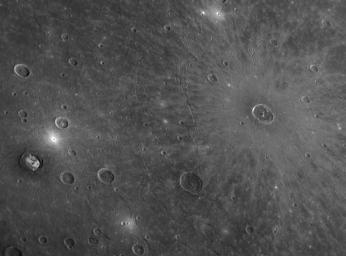
|
Young Cunningham Crater in Old Caloris Basin
- Click the image above for a larger view
- Full-Res JPEG (1018 x 754) (102.0 kB)
- Full-Res TIFF (1018 x 754) (768.6 kB)
Caption:
Mercury's giant Caloris basin is the best-preserved large impact basin known on Mercury, and the high density of craters on its floor indicates that the basin is fairly old and probably formed about 3.8 billion years ago. This NAC image shows an area on the plains that partially fill the Caloris basin floor. On the right portion of this image, the light-colored rays emanating from Cunningham crater (named for the American photographer Imogen Cunningham) show that this crater is relatively young; bright ejecta rays tend to darken with time, as the ejected material is gradually modified by impacting micrometeoroids and solar particles (a suite of different processes that together are called "space weathering"). Relative age relationships such as this one are used to unravel Mercury's geologic history. The similar-sized Kertész crater is also visible on the left side of this image.
Date Acquired:
January 14, 2008
Image Mission Elapsed Time (MET:
108828535
Instrument:
Narrow Angle Camera (NAC) of the Mercury Dual Imaging System (MDIS)
Resolution:
520 meters/pixel (0.32 miles/pixel)
Scale:
Diameter of Cunningham crater is 37 kilometers (23 miles)
Spacecraft Altitude:
20,300 kilometers (12,600 miles)
Background Info:
These images are from MESSENGER, a NASA Discovery mission to conduct the first orbital study of the innermost planet, Mercury. For information regarding the use of images, see the MESSENGER image use policy .
Cataloging Keywords:
| Name | Value | Additional Values |
|---|---|---|
| Target | Mercury | |
| System | ||
| Target Type | Planet | |
| Mission | MESSENGER | |
| Instrument Host | MESSENGER | |
| Host Type | Orbiter | |
| Instrument | Mercury Dual Imaging System (MDIS) | |
| Detector | Narrow Angle Camera (NAC) | |
| Extra Keywords | Crater, Grayscale, Impact | |
| Acquisition Date | ||
| Release Date | 2008-06-10 | |
| Date in Caption | 2008-01-14 | |
| Image Credit | NASA/Johns Hopkins University Applied Physics Laboratory/Carnegie Institution of Washington | |
| Source | photojournal.jpl.nasa.gov/catalog/PIA10935 | |
| Identifier | PIA10935 | |
